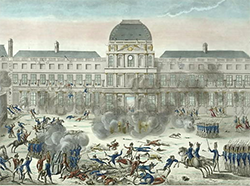The Legislative Assembly of France
The Legislative Assembly was the lawmaking body of France in 1791–1792, in the shadow of the French Revolution. 
The National Constituent Assembly had drawn up the Constitution of 1791, which King Louis XVI had approved in September of that year. The Legislative Assembly, designated France's supreme lawmaking body by the Constitution, first met on Oct. 1, 1791. By specific prohibition of the National Constituent Assembly, none of its members could be elected to the Legislative Assembly. So when the new Assembly gathered, none of its 745 members had served in a similar capacity previously. Many deputies, as the members of the new legislative body were called, came from the Jacobin Club, which had not been represented in the previous Assembly. Jacques Brissot, Pierre Cambon, and the Marquis de Condorcet were Jacobin leaders in the Legislative Assembly. 
Many in the Assembly, like Brissot, were Republicans (meaning those wanting a republic form of government) and wanted to do away with the monarchy altogether and saw the 1791 Constitution as an impediment to that desire. Brissot and others championed a war with neighboring countries like Austria because they thought that they could take advantage of instability caused by such a war and topple King Louis XVI. The name most often given to Brissot and his followers was Girondin (since many were from the Gironde). Brissot was the author of a July 1791 petition to remove the king from power. At a gathering on the Champ de Mars of a large number of people to sign the petition, the Marquis de Lafayette and his National Guard convinced the crowd to avoid violence and to disperse. When the crowd returned larger and angrier later that same day, violence resulted: Hostile words led to hostile acts, as protesters threw rocks at Guardsmen; Lafayette ordered shots into the air; and, when the crowd didn't go away, he ordered his men to fire into the crowd, killing and injuring dozens. On the other end of the political spectrum were the Feulliants, who supported the king and the constitutional monarchy. Of the 745 deputies, 260 were Feulliants, 136 were Jacobins, and the rest had no political affiliation. The Legislative Assembly pursued several reforms to bring about more equality among the population at large, including the assumption by the civil government of powers previously held by the Catholic Church. One significant reform for women gave them the right to get a divorce, a power that they did not have. The Assembly was also particularly concerned with the émigrés, nobles and others who left the country, suspecting them of conspiring against the new government. 
The Girondins got their war when France declared war on Austria on April 20, 1792. However, the Prussians soon came to the aid of the Austrians, and the joint forces routed French troops in the field. One of the charges against Louis XVI at this time was conspiring with the enemy. The king did indeed want a war because he thought it would give him the opportunity to reclaim his authority, as much of it as he could conceivably take. Louis XVI had also vetoed several bills passed by the Legislative Assembly, most prominently a bill labeling émigrés–people, mostly nobles, who had left the country and, in many cases, had conducted political intrigue from without. Another disappointment for the Assembly was the king's veto of a decree that required religious authorities to take the civic oath. 
Louis had also, under the terms of the Constitution of 1791, held on to the power of appointing his ministers. Of those he appointed in 1791, many were Feulliants and several more had no business having their jobs. By the summer of 1792, the Jacobins had taken control of the Assembly and were advancing their advocacy of removal of the king at every opportunity. On August 10, things boiled over entirely and a group of protesters stormed the Tuileries, seizing the king and the royal family and placing them in lockdown in the Square du Temple. Meanwhile, the Legislative Assembly called for a new National Convention, which met for the first time on Sept. 21, 1792.
|
|
Social Studies for Kids
copyright 2002–2026
David White




